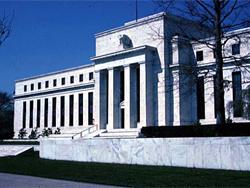Fed Cuts Rates By a Quarter Point
Washington, DC, October 31, 2007--The Federal Reserve cut interest rates but said the risk of inflation was roughly equal to downside risks to growth, suggesting further rate reductions are far from a sure bet.
The decision by the central bank's Federal Open Market Committee to lower the overnight federal funds rate by a quarter-percentage point to 4.5% was widely expected in financial markets.
In announcing its decision, which follows an aggressive half-point reduction in rates made last month, the policy-setting Federal Open Market Committee said its actions should put the economy on better footing and had brought inflation and growth risks into rough balance.
"Today's action, combined with the policy action taken in September, should help forestall some of the adverse effects on the broader economy that might otherwise arise from the disruptions in financial markets and promote moderate growth over time," the central bank said.
The Fed's vote was not unanimous. Kansas City Federal Reserve Bank President Thomas Hoenig dissented, preferring to hold borrowing costs steady.
"Recent increases in energy and commodity prices, among other factors, may put renewed upward pressure on inflation," the Fed said. "In this context, the committee judges that some inflation risks remain."
After this action, the upside risks to inflation roughly balance the downside risks to growth," it added.
Prices for interest rate futures contracts showed dealers were scaling back bets on further rate cuts on the back of the Fed's announcement, implying a 50% chance the Fed will lower rates again in December down from 64% overnight.
Credit markets, which were roiled in August as concerns mounted over rising delinquencies in the mortgage market, have regained some stability since the Fed lowered rates by a half-percentage point on September 18.
Fed officials have said they expect the housing slump and the after-effects of tighter credit to weigh on the economy into next year.
A string of gloomy economic reports in recent weeks, including slipping consumer confidence and tumbling home sales, had raised fears the economy might be weaker in coming quarters than the Fed had anticipated.
